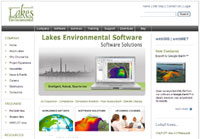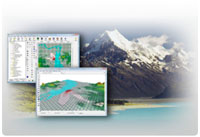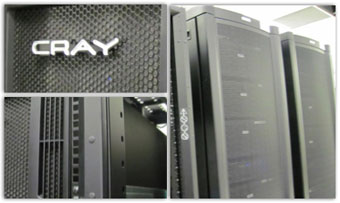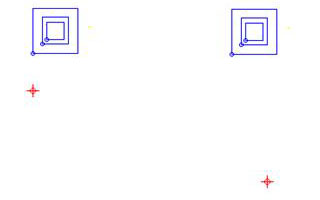Lakes Environmental e-Newsletter
News & Events
Lakes Environmental Releases New Website!
Lakes Environmental has a fresh new look! We are pleased to announce our new website, which makes finding information about Lakes Environmental’s products and services faster and easier. Our website still contains essential information for our users, like our Knowledgebase and links to both WebGIS and webMet, however it now also includes:

- simplified navigation
- improved method for ordering met data
- guidance about how to choose which Lakes Environmental software is right for your needs
Check us out today at www.weblakes.com!
AERMOD & CALPUFF Courses in Barcelona
Lakes Environmental is delighted to be returning to Spain for a week of AERMOD and CALPUFF training in Barcelona. We are proud to be a leading provider worldwide of powerful training for US EPA air dispersion models, with instructors being continuously rated as “outstanding” by course attendees.
The course will be hosted by our Spanish distributor, Addlink Software Cientifico. Presentation of the course as well as all course materials will be in English. We encourage you to register soon in order to reserve your spot. If you are interested in registering for the AERMOD and CALPUFF courses, please contact Addlink at info@addlink.es or visit their website for further details.
Register today to take advantage of our early registration discount!
Lakes Environmental Offering AERMOD Modeling Run Services
Lakes Environmental has recently acquired a CRAY® Supercomputer, which, combined with AERMOD MPI, can complete complex multi-hour runs in a matter of minutes. With this powerful capability, we now offer a modeling input file run service. To complete your modeling project quickly, submit your completed AERMOD projects to us, which will be run on our supercomputer in a fraction of the time required for a traditional model run. Please contact support@weblakes.com if you have any questions or need a quote for this service.
Featured Product - CALPUFF View 3.0
Lakes Environmental’s CALPUFF View software provides a complete graphical solution for the CALPUFF modeling system; CALPUFF, CALMET, and CALPOST, along with their related pre and post processors. CALPUFF View conveniently supports the EPA approved version 5.8 as well as the advanced version 6.0 of the CALPUFF system, providing you with access to the all of the latest models and enables you to quickly and easily switch between versions at any point in your modeling. Our recent release of CALPUFF View 3.0 has introduced many exciting new features, including:

- Export to Google Earth, including both full project export as well as puff tracking animations
- Automatic download of terrain and land use data, no matter what the project location worldwide, geo-processing has never been easier
- A regulatory settings button, which will set all of the required parameters to their EPA recommended values
- Nested receptor grids
- An improved new project wizard
CALPUFF View 3.0 makes it easy to utilize the powerful capabilities of the CALPUFF modeling system. If your air dispersion project involves complex wind fields, long range transport, coastal effects, complex terrain, or requires sub-hourly times steps, CALPUFF may be the right modeling system for you!
Lakes Environmental has recently announced exciting promotional pricing for its CALPUFF View software. Pricing for this package is now $3,495.00 US, an incredible savings of $1,000.00 US!
Our Sales Team has also begun promoting a campaign to our current CALPUFF View users which could save you 20% on your maintenance renewal!
Contact us at sales@weblakes.com today for further details!
Lakes Environmental Closed For Labor Day
Lakes Environmental will be closed on Monday, September 7th to observe the Labor Day holiday. If you have any pressing needs during that time, please e-mail us at support@weblakes.com and we will contact you on September 8th, 2009 when our offices reopen.
Upcoming Courses
Date |
Course |
Location |
Registration |
Sep 14-15, 2009 |
|||
Sep 28-29, 2009 |
AERMOD |
||
Oct 19-20, 2009 |
|||
Nov 09-10, 2009 |
Sao Paulo, SP - Brazil |
||
Nov 16-17, 2009 |
For more information on the above courses, including registration information, location, and course outlines, please visit our web site: https://www.weblakes.com/courses.html.
Modeling Tip
Datum
A Datum is a reference from which measurements are made; in terms of mapping, a datum is a set of reference points along with a reference ellipsoid (used to describe the shape of the earth) which is used to define a geographical coordinate system.
Datums in Air Dispersion Modeling
Because the datum can have a significant affect on coordinates, it is important to use a consistent datum throughout an air dispersion modeling project.
For example, if a building location is taken from a map that uses the NAD27 datum, and a source location is taken from a GPS reading, using WGS84, the relative distance between the source and the building could be incorrect; leading to a faulty downwash analysis.
Actual Building and |
Building and Source Locations with Inconsistent Datums |
Submit Your Modeling Tip Today!
We are currently accepting submissions for the Monthly Modeling Tip that appears in our newsletters. If you have a modeling tip that may benefit a variety of people, please send it to us at support@weblakes.com. Your name and the name of your organization will appear below the tip providing you with greater exposure.
Articles
The Psychology of Climate Change
August 9, 2009 - GLOBE-Net - While most Americans think climate change is an important issue, they don’t see it as an immediate threat, so getting people to "go green" requires policymakers, scientists and marketers to look at psychological barriers to change and what leads people to action, according to a task force of the American Psychological Association (APA).
Scientific evidence shows the main influences of climate change are behavioral - population growth and energy consumption. "What is unique about current global climate change is the role of human behavior," said task force chair Janet Swim, PhD, of Pennsylvania State University. "We must look at the reasons people are not acting in order to understand how to get people to act."
Read Article
Climate Change Seen as Threat to U.S. Security
August 8, 2009 - WASHINGTON - The changing global climate will pose profound strategic challenges to the United States in coming decades, raising the prospect of military intervention to deal with the effects of violent storms, drought, mass migration and pandemics, military and intelligence analysts say.
Such climate-induced crises could topple governments, feed terrorist movements or destabilize entire regions, say the analysts, experts at the Pentagon and intelligence agencies who for the first time are taking a serious look at the national security implications of climate change.
Read Article
A Source of Haze
August 7, 2009 - Scientists now know how a natural hydrocarbon emitted in large quantities by plants can be transformed into light-scattering aerosols that contribute to haze and influence climate. The finding will improve models of atmospheric chemistry and climate and may help explain puzzling field observations in some parts of the world, the researchers report.
Worldwide, plants release more than 550 million metric tons of the hydrocarbon isoprene into the atmosphere each year. But scientists have disagreed about the particular chain of chemical reactions that transform isoprene into haze-forming aerosols, says Fabien Paulot, an atmospheric chemist at the California Institute of Technology in Pasadena. Now, lab tests by Paulot and his colleagues, reported in the Aug. 7 Science, have identified a new class of substances long suspected to form as an intermediate in those reactions but never before seen.
Read Article
Japanese Utilities to Test 'Low Emissions' Coal Plant
August 6, 2009 – GLOBE-Net - Two of Japan’s largest utilities - Electric Power Development Co., Ltd. (J-POWER) and The Chugoku Electric Power Co., have joined forces in a new company, Osaki CoolGen Corporation, to undertake a large-scale demonstration test of oxygen-blown coal gasification combined cycle technology and CO2 separation and recovery technology.
To date both companies have positioned coal, which offers both stable supply and economic efficiency, as an important and continuing energy source for Japan, and have worked toward improving its efficiency through high-temperature, high-pressure steam conditions in coal-fired power generating sites.
Read Article
Arctic Ocean May be Polluted Soup by 2070
August 6, 2009 – WITHIN 60 years the Arctic Ocean could be a stagnant, polluted soup. Without drastic cuts in greenhouse-gas emissions, the Transpolar Drift, one of the Arctic's most powerful currents and a key disperser of pollutants, is likely to disappear because of global warming.
The Transpolar Drift is a cold surface current that travels right across the Arctic Ocean from central Siberia to Greenland, and eventually out into the Atlantic. It was first discovered in 1893 by the Norwegian explorer Fridtjof Nansen, who tried unsuccessfully to use the current to sail to the North Pole. Together with the Beaufort Gyre, the Transpolar Drift keeps Arctic waters well mixed and ensures that pollution never lingers there for long.
Read Article
Upcoming Conferences & Trade Shows
Date |
Conference |
Location |
Aug 24-26, 2009 |
5th Australia-New Zealand Climate Change Business Conference |
Melbourne, Australia |
Aug 31-Sep 2, 2009 |
Harmonizing Greenhouse Gas Assessment and Reporting Processes |
Baltimore, Maryland, USA |
Sep 15-16, 2009 |
Air Quality Impacts of Oil and Gas Production in the Rocky Mountains |
Centennial, Colorado, USA |
Sep 22-24, 2009 |
Carbon Capture and Storage World Summit |
Arlington, Virginia, USA |
Sep 23-25, 2009 |
9th International Conference and Exhibition on Emissions Monitoring (CEM 2009) |
Milan, Italy |
Oct 26-27, 2009 |
Carbon Forum Asia 2009 |
Singapore |
Oct 26-29, 2009 |
Air Quality VII Conference |
Arlington, Virginia, USA |
Nov 16-19, 2009 |
11th International Symposium on Environmental Issues and Waste Management in Energy and Mineral Production (SWEMP 2009) |
Banff, Alberta, Canada |
About this Newsletter
This newsletter contains information gleaned from various sources on the web, with complete links to the sources cited. Organizations cited are in no way affiliated with Lakes Environmental Software.
Lakes Environmental Software is a leading environmental IT company that offers a complete line of air dispersion modeling, risk assessment, emissions inventory, and emergency release software as well as training and custom software services. With satisfied users located around the globe, Lakes Environmental Software will continue to revolutionize the environmental software field.
For more information please visit our web site at: www.weblakes.com. You may also contact us by phone at (519) 746-5995 or by fax at (519) 746-0793.
All comments and suggestions are welcome. You can e-mail us at: support@weblakes.com.








